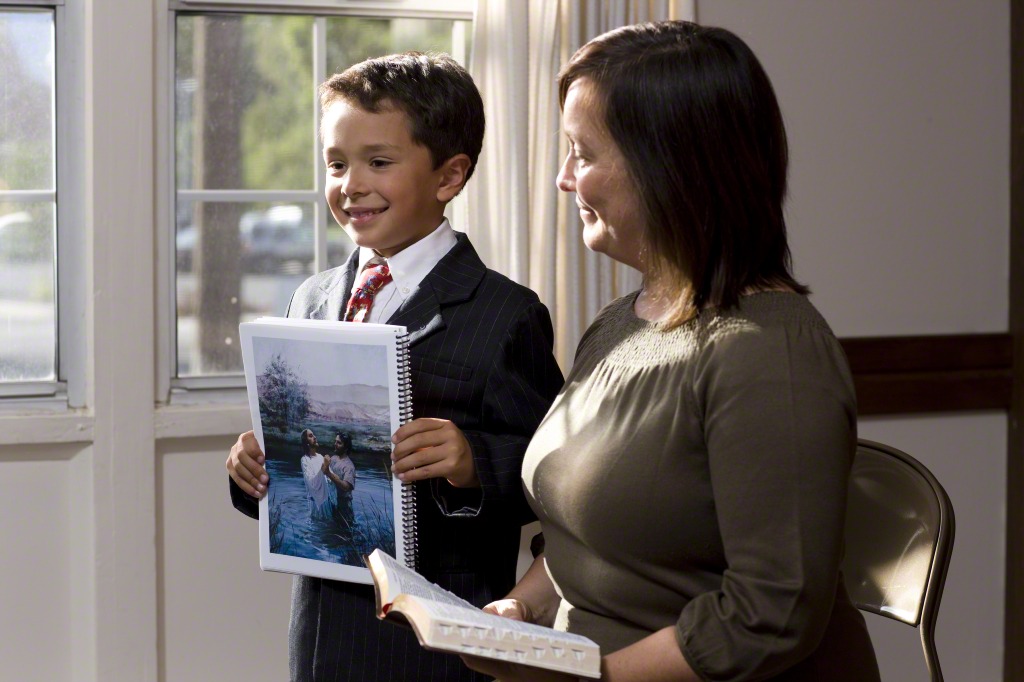We ask thee, O Lord, to accept of this house, the workmanship of the hands of us, thy servants (D&C 109:4).
In Kirtland, Ohio, in 1836, Joseph Smith dedicated the first latter-day temple so that “the Son of Man might have a place to manifest himself to his people” (D&C 109:5).
Work had begun on the temple on June 5, 1833. For the next three years the Saints endured many trials and hardships in order to build a house for the Lord.
Most of the people had few possessions and little money. But every able man worked one day each week on the temple. They worked in the quarry, cutting sandstone to form the walls of the temple. They worked as carpenters, painters, teamsters, and in many other jobs. Sometimes as many as a hundred men worked on the temple at a time. The women spun, knitted, wove, and sewed to make draperies and carpets. They also made clothing and food for the construction workers.
Everyone was busy, but it was not just the Saints’ time and talents that the Lord required. The large three-story building cost between $40,000 and $60,000, an enormous amount of money at a time when the average worker earned only around two or three dollars a day. Many of the Saints gave almost everything they had to build the temple.
Some people in the area opposed its construction. Mobs came at night to destroy work done and to steal tools and supplies. It became necessary for men to stand guard each night.
When the temple was completed, it was the most beautiful building for miles around. Inside were two curved stairways and beautiful wood moldings and railings. But it will be remembered forever not for its beauty but for the marvelous events that happened there.
On Sunday, March 27, 1836, hundreds of Latter-day Saints came to Kirtland for the dedication. The doors opened at 8:00 a.m., and one thousand people entered. Hundreds more were left outside. They had also worked and sacrificed for the building of the temple. Seeing their disappointment, Joseph Smith decided to repeat the dedication on Thursday.
The choir opened the meeting, then President Sidney Rigdon spoke for two and a half hours. After a brief intermission, the officers of the Church were sustained. Then the Prophet offered the dedicatory prayer, given to him by revelation. This prayer is now section 109 of the Doctrine and Covenants [D&C 109]. After the prayer, the choir sang “The Spirit of God,” which had been written specifically for the dedication.
The congregation ended the seven-hour service by standing and giving the sacred Hosanna Shout. Sister Eliza R. Snow said that it was given “with such power as seemed almost sufficient to raise the roof from the building.”
That evening over four hundred priesthood bearers again met in the temple, and while George A. Smith was speaking, “a noise was heard like the sound of a rushing mighty wind which filled the temple, and all the congregation simultaneously arose, being moved upon by an invisible power.” Many men began to speak in tongues and to prophesy. Others saw glorious visions, including angels who filled the temple.
People living nearby heard the sound, too, and ran to see what was happening. As they approached, they beheld a pillar of fire resting upon the temple, saw angels hovering over the temple, and heard heavenly singing.
Many other spiritual manifestations took place in the temple that year. Prescindia Huntington described how a little girl came to her door during one meeting and called out in excitement, “The meeting is on top of the meeting house!” Prescindia looked outside and saw angels walking back and forth on the temple. Many children in Kirtland saw the angels and remembered the glorious sight the rest of their lives.
One week after that first dedication, on Easter Sunday, April 3, 1836, Joseph Smith and Oliver Cowdery stood in the pulpit area of the temple and dropped the veils around the pulpit so they could be alone to pray. After their prayer, they saw the Lord standing upon the pulpit. “His eyes were as a flame of fire; the hair of his head was white like the pure snow; his countenance shone above the brightness of the sun; and his voice was as the sound of the rushing of great waters” (D&C 110:3). Jesus told Joseph and Oliver that He accepted the temple and that in that house He would “appear unto my servants, and speak unto them with mine own voice, if my people will keep my commandments, and do not pollute this holy house” (D&C 110:8).
After this vision, Moses, Elias, and Elijah appeared and gave to Joseph and Oliver the keys necessary to continue the Lord’s work upon the earth. Among these keys was the sealing power that seals husbands to wives and children to parents for all eternity.
This was a time of rich blessings. Even though the temple was used only for a few years before the Saints were driven out of Kirtland, it was worth every dollar spent, every minute worked, and every hardship endured, because the Lord had indeed manifested Himself to His people.
(Information included in this article came from History of the Church, volume 2, page 428; Joseph Smith’s Kirtland, by L. Anderson, page 177; and Eliza R. Snow, an Immortal: Selected Writings of Eliza R. Snow, by Nicholas G. Morgan, page 62.)
Talk Source:



